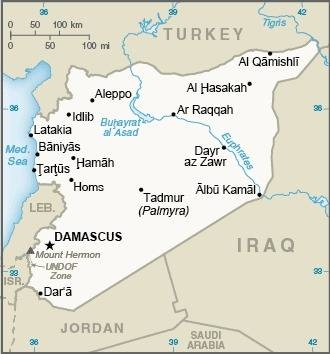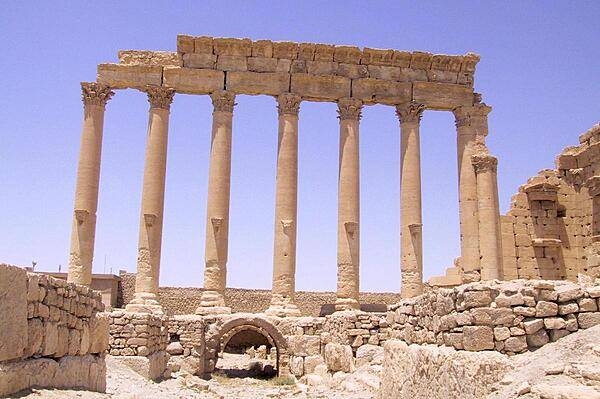167 Syria

Three equal horizontal bands of red (top), white, and black. Two small, green, five-pointed stars in a horizontal line centered in the white band. The band colors derive from the Arab Liberation flag and represent oppression (black), overcome through bloody struggle (red), to be replaced by a bright future (white). Identical to the former flag of the United Arab Republic (1958-1961) where the two stars represented the constituent states of Syria and Egypt. The current design dates to 1980.
Flag courtesy of the CIA World Factbook

Map courtesy of the CIA World Factbook

Temple ruins at Palmyra in central Syria. Palmyra has a long history extending back at least to the early second millennium B.C. The city changed hands between different empires on a number of occasions before becoming a subject of the Roman Empire in the first century A.D. Palmyra accumulated great wealth as a nexus for trade caravans, which then allowed for the construction of monumental building projects, many of which survive in a ruined state.
Photo courtesy of the CIA World Factbook
Government
According to Britannica, the constitution of 1973 declares that Syria constitutes an integral part of the Arab homeland, that all legislative power lies with the people, and that freedom of expression and equality before the law are guaranteed. However, the enforcement of these principles has not been thorough; especially from the late 1970s, constitutionally guaranteed rights were increasingly suppressed under Pres. Hafez al-Assad’s rule.
Syria is a unitary multiparty republic with one legislative house. The regional (Syrian) leadership of the Arab Socialist Baʿath (Renaissance) Party elects the head of state, who must be a Muslim, and appoints the cabinet, which exercises legislative as well as executive powers. Legislative power is vested in the People’s Council, members of which are elected by popular vote to four-year terms. The Baʿath Party is constitutionally guaranteed an absolute majority.
Syria is divided into governorates (one of which, Damascus, is a governorate-level city), manāṭiq (districts), and nawāḥī (subdistricts). The governors, or muḥāfiẓūn, enjoy some power within their administrative divisions, but local government is centralized and is dependent upon the minister of the interior in the national government.
The principles of Syrian law and equity derive basically from Islamic jurisprudence and secondarily from the French civil code. Summary courts try civil, commercial, and penal cases. The headquarters of each administrative district has a First Instance Court for criminal cases. The capital city of each governorate also has a court of appeal. Damascus houses a high court of appeal and a constitutional court, as well as a military tribunal and the mufti’s court for the maintenance of Islamic law. Various non-Muslim sects each have their own courts with jurisdiction over personal-status cases.
Civil / National Aviation Authority (CAA/NAA)
The Civil Aviation Authority was created after independence as a department affiliated to the Ministry of Works and Transport and then turned into a general directorate linked to the same ministry at the beginning of the fifties. In 1958, it was attached to the Ministry of War, then to the Ministry of Defense in 1961, and then to the Ministry of Transport under Legislative Decree No. /93/ of 1974. The 1961 legislative decree summarized the tasks of civil aviation by representing the country outside the territory of the Syrian Republic to implement international civil aviation regulations, in implementation of Article 37 of the International Civil Aviation Treaty signed in Chicago in 1944, where the Syrian Arab Republic became a party to it later after independence. The Chicago Treaty also sets out the basic rules, facilities and recommendations relating to international civil aviation which are included in Annex IX of this Treaty at the Organization’s meeting. On 5/2/1949, Law No. /20/ dated 9/11/2003 was issued establishing the General Organization for Civil Aviation to replace the General Directorate of Civil Aviation as a public institution of an economic nature, enjoying financial and administrative independence, affiliated with the Ministry of Transport and subject to the provisions of Legislative Decree No. 20 of the year 1994. The General Authority for Civil Aviation is managed by the Foundation’s Board of Directors / Director General of the General Civil Aviation Organization. The internal system accompanying the General Civil Aviation Corporation (SCAA) was also approved, which was issued by Resolution No. 733.
Airspace
SkyVector – Google Maps – ADS-B Exchange
ICAO countries publish an Aeronautical Information Publication (AIP). This document is divided into three parts: General (GEN), En Route (ENR) and Aerodromes (AD). ENR 1.4 details the types of airspace classes they chose to adopt from classes A through G.
none found
Drone Regulations
Currently, there is no legal framework for the use of drones.
Advanced Air Mobility (AAM)
Short Essay Questions
Question 1
You have been hired by a Drone Startup Company. Your boss has immediately assigned this job to you.
They need you to prepare a one-page memo detailing the legalities of using a drone to film the temple ruins, pictured above.
They need you to mention any national laws and local ordinances.
They specifically want to know what airspace you will be operating in and whether or not you need an airspace authorization.
Does it matter whether or not you are a citizen of the country?
Lastly, there is a bonus for you if, as you scroll through this chapter, you find any typos or broken links!
Question 2
Do you need a certificate to fly UAS?
If so, how do you obtain one?
Are there fees associated with this?
If so, how much?
Question 3
May you operate beyond visual line of sight?
If so, what procedures must you follow?
Question 4
Does the country have UAM/AAM laws? If so, describe, citing the exact law.
Question 5
Are you aware of any new laws or policies not mentioned above? If so, describe, citing the exact law or policy.

